When you’re decorating your home, painting walls and rearranging furniture can really make a room feel and look brand new and exciting. However, painting radiators is a great way to breathe new life into a room. In fact, it is a vital step in renovating any room. Newly painted walls can really make a radiator look down in dumps and old. If you’re about to paint a few rooms in your home and want to paint the radiators in that room too, you’re in the right place.
Today, we’re exploring the best radiator paint available within the best UK paint brands. We’ll also be talking through how to paint a radiator with a paintbrush or a spray can. And tackling some FAQs about painting radiators as well. First, though, let’s find out what makes radiator paint special and why you shouldn’t use anything else to paint your radiators, shall we?

As radiators get hot and cold pretty much constantly throughout the year, you need paint that can handle these temperature changes. If you don’t use a paint designed for the job, you will end up with peeling paint that looks terrible.
Radiator paint is designed to cope with these temperature changes and very high heat. The paint can be either oil-based enamel paint or water-based enamel paint.
It is the enamel part of the recipe that means it works well on radiators. It is extremely hard wearing and is very unlikely to scratch or peel if something knocks on your radiator, which is great for protecting the metal and the overall finish.
However, the main thing about this paint that makes it special is that it withstands the large amounts of heat that your radiator lets off.
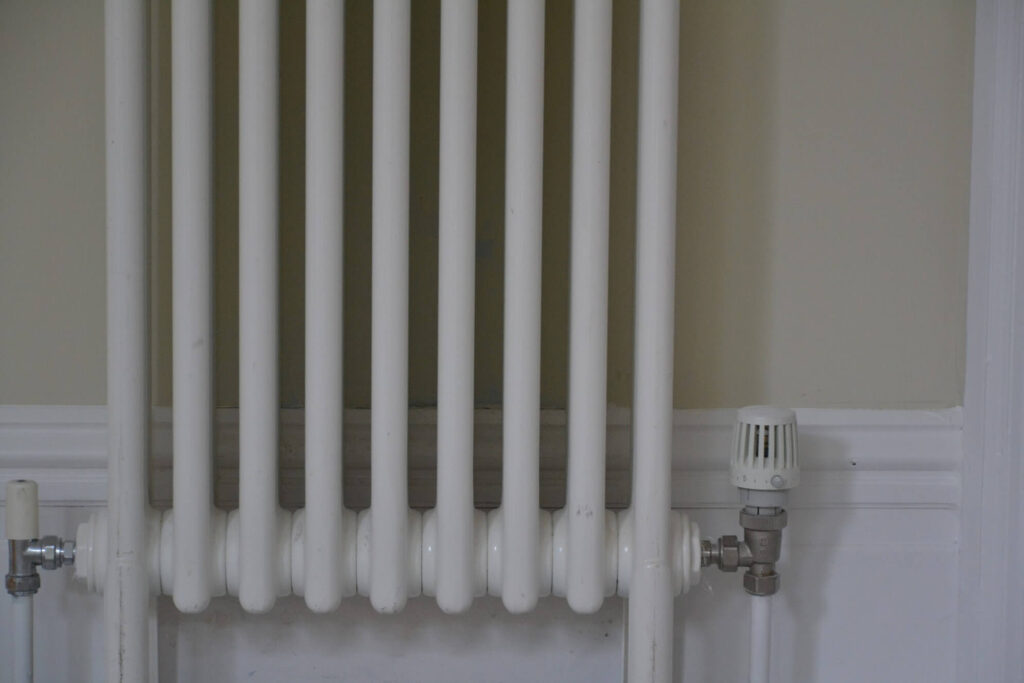
There is loads of radiator paint on the market at the moment. You can choose between cans of radiator paint and spray paint designed for radiators. Some radiator paints come in different colours now too. For a long time, radiator paint came in gloss white or gloss white. Now, though, you can choose a whole host of colours and finishes.
The best colour and finish to choose for your radiator greatly depends on the look you are going for in the room. Some people like to match the colour of the radiator with the wall. Others like a contrasting look. While some like to keep radiators looking traditional with the classic white gloss. If you are redecorating your home, really have a think about the colour of your radiators. Changing the colour can really make a room a very exciting and beautiful space.
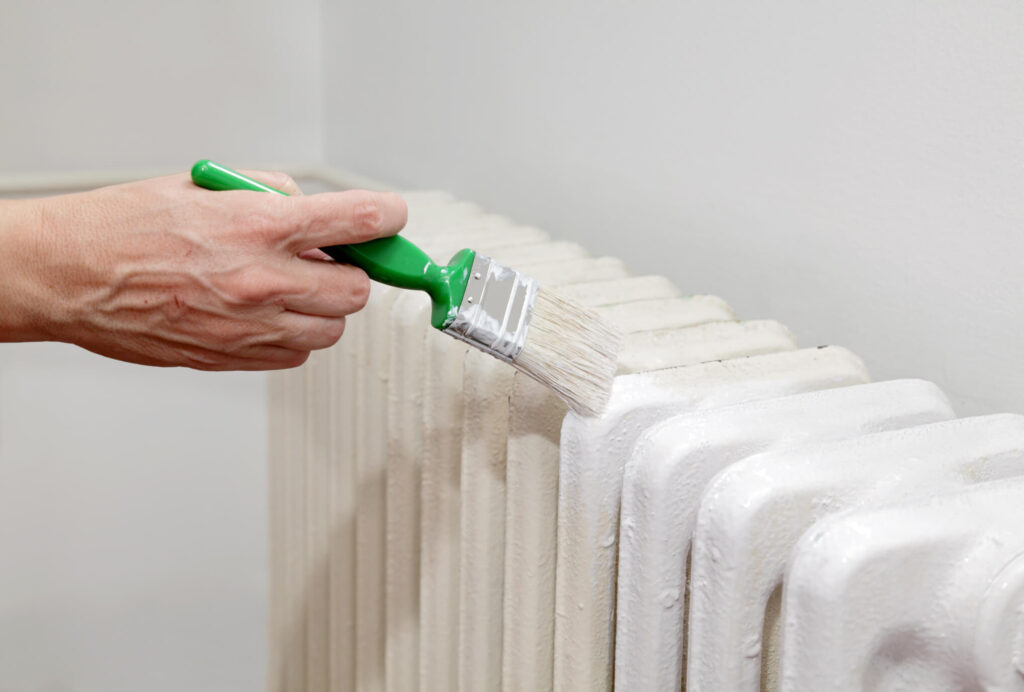
JENOLITE makes some exceptional heat resistant paint in a good choice of colours. This radiator paint is the classic white gloss, but what a beautiful glossy shine it is. If you are after the traditional look for your radiators, you won’t go far wrong with this paint. It will also stay white for much longer than most radiator paint as it has an excellent non-yellowing formula.
While the bright gloss finish is looking wonderful on the surface, underneath, the paint is working overtime, protecting your radiator from rust and corrosion. All while the paint is heating up and cooling down and never failing at all. As we said, JENOLITE makes heat resistant paint in a few colours; this is just one very good example.
This heat resistant, quick-dry paint is perfect for touching up white appliances as well radiators. It is white gloss, so it will match fridges, freezers and a lot of other appliances too. It also dries in 30 minutes, making this radiator paint some of the fastest on the market. As this does dry very quickly, it is best to do a few coats rather than going over areas too much. If you do, the paint can stick and clump together.
If you follow the instructions, this radiator paint is really fast and offers a fantastic gloss-white finish. It is also water-based enamel paint, so there is much less odour when working with it than oil-based paints.
Hammerite makes some of the best metal paint on the market. Its radiator paint is certainly no exception to this. Hammerite has created this paint especially for radiators and hot water pipes, but you can use this on cold water pipes too. So, you can protect from heat, but also from rusting and yellowing too.
This paint has a very low odour yet provides one of the longest-lasting protections of any paint in this category. You must use this paint in a well-ventilated area, though, as there are chemicals in the paint to prevent rusting and protect the paint from temperature changes. Still, this radiator paint is one of the best on the market and is nice and easy to get a great finish with.
Ronseal One Coat Radiator Paint is a very impressive, extremely durable paint. It is a beautiful satin white that is non-yellowing and provides a lot of protection to your radiator. This paint is also really fast drying. In just 30 minutes, you have a touch dry radiator that will be looking beautiful. Also, there is no strong smell with this paint at all, which is excellent in tight working conditions
Ronseal makes extremely good paints and finishes that really don’t cost the earth, and this radiator paint is a prime example of that. Sure the can is only 250ml, but it offers excellent coverage with just one coat. This can is enough to cover 13m2, easily enough white satin paint for a few radiators in this tin.
This cleverly designed spray radiator paint offers rust and moisture protection. It is a non-yellowing paint that is quick-drying and really easy to apply. In fact, it is incredibly simple to achieve a really good finish with this radiator spray paint. Once you are finished, you’ll have a washable surface that will stay looking great for years to come.
This radiator paint is a satin white too. Going from a glossy white to a satin white may not sound like a big change, but it can really bring your radiators into the 21st century and make them look fantastic. If you do choose this excellent spray paint, we would recommend you buy a few cans, just to make sure you have enough for a second coat in case your radiator needs one.
JENOLITE is back on our best radiator paint list with one of the best spray paints we have ever seen. This enamel, white gloss spray paint is simply fantastic. It is heat resistant up to 130 degrees Celsius. It is also rust and corrosion resistant and won’t yellow over time either.
If you want to refresh and protect your radiator, this is the paint to use. It dries in about 60 minutes and will provide long-lasting protection to your radiator from scruffs and scraps. Finally, this radiator spray paint can be applied without the use of a primer, making it even quicker to get a great finish. Oh, and this is also a three-pack, so you’ll have plenty of paint for all the radiators in a room.
One of the things that Plasti-Kote does better than any other spray paint company is making spray paint with a nozzle that doesn’t clog and is actually nice to use. When spraying a radiator a beautiful satin white, you need to take care and focus on the job. Rather than focusing on your hand that is cramping because of the spray paint can. You’ll have no worries here with Plasti-Kote’s excellent spray nozzle.
What comes out of the can is also exceptional too. It is a non-yellowing, heat resistant satin white spray paint that can transform the look of your radiators nice and quickly. This spray offers a very durable and professional finish for your radiators, and that is why it easily made our list.
Up to now, all of the radiator paint we have offered has been gloss or satin white, which provides an excellent look. However, if you fancy a radiator with a classy, modern look, this could be the paint for you. This is gloss grey, but other colours are available too. WRX are changing what is possible with interior decorating with their range of spray paints. This paint is heat resistant up to 200 degrees allowing you to paint just about any hot surface in the home any colour you desire.
We love this grey gloss, but take a look at WRX’s catalogue for even more inspiration and options. The spray paint itself is of fantastic quality and goes on like a dream. It is incredibly simple to get a brilliant finish with this spray paint because the paint is very high quality, but so is the spray can!
If your radiator simply needs a bit of sprucing up, perhaps it has a few chips; for example, touch up paint could be all that’s needed. Some enamel touch up paint is a must-have in the home. Scratch Doctor enamel touch up paint can be used on loads of surfaces, including sinks, baths, outdoor furniture, fridges and radiators.
With this paint, you can easily restore a radiator back to new and keep it looking great for years. It fixes scratches and chips like no other touch up paint on the market. The reason we chose this touch paint for our list of the best radiator paints in the UK, though, is because it is so easy to apply. It takes minutes to make your radiator look fantastic once more.
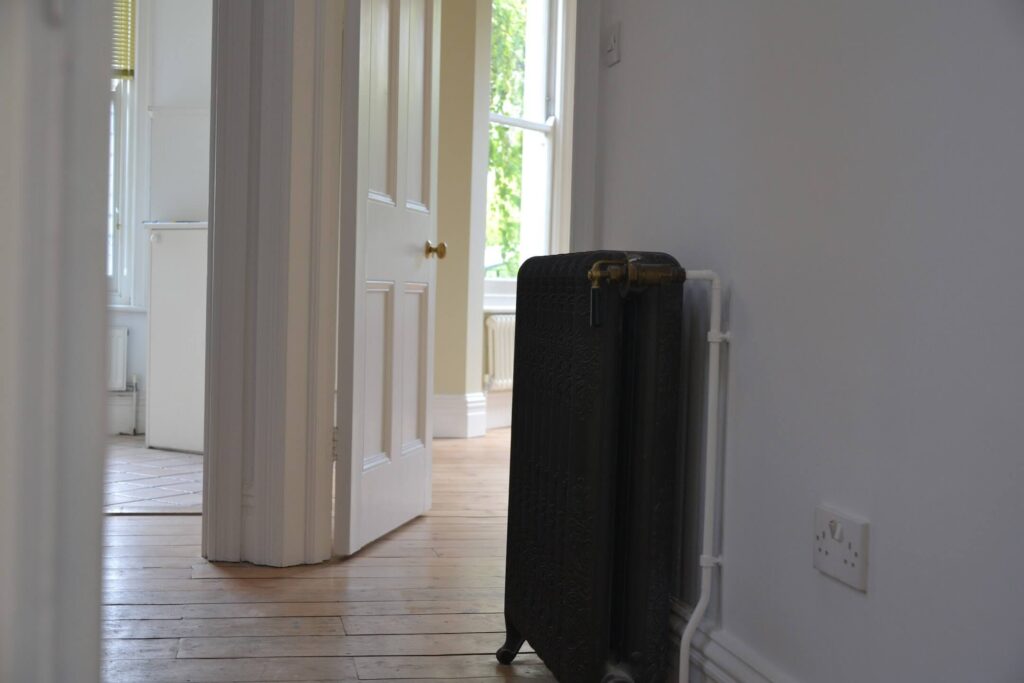
As with all painting jobs, preparation is a very important step. Preparing the radiator and the walls surrounding it correctly will make the difference between a job done right and having to stare at mistakes for years.
The first step of preparation is to turn your radiator off and let it cool down. If you don’t turn your radiator off, the paint will dry unevenly, and it will also make painting your radiator rather difficult and warm!
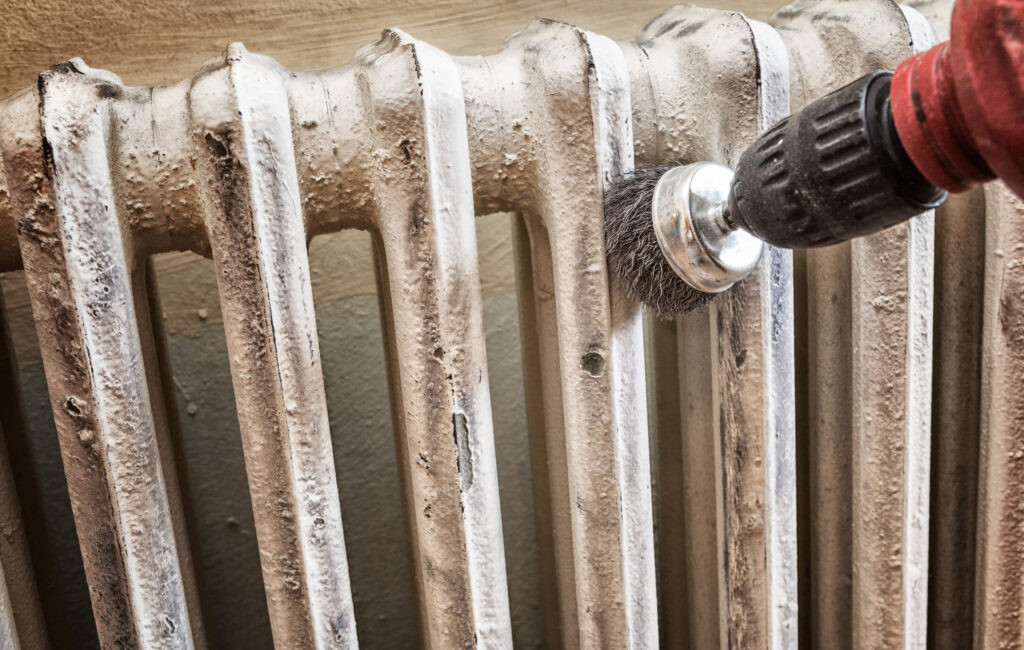
Next, give your radiator a good clean. This ensures there is no dust or grime on your radiator that could prevent the paint from sticking to it properly. To start the cleaning process, use a duster or a dry microfibre cloth to remove any loose dust. Then, use a damp microfibre cloth (a fresh one) to remove any more stubborn dirt. Let your radiator dry before moving on to the next step.
Now that the radiator is clean, you need to give it a good sanding and scruff up the paint that is already on it. This is particularly important if your radiator has gloss paint on it already. A fresh coat of paint won’t adhere to the gloss paint, and so you must sand it to give it some tooth to allow the new paint to lay nicely on the surface.
If the paint on your radiator is in good condition, you don’t need to sand back to bare material. Just simply scruff up the paint. If the paint job is really uneven, sanding back through the layers to achieve an even surface is well worth it as it will offer a much better finish. Once you’ve completed sanding, you will need to clean your radiator again to make sure no paint dust is left on the surface.
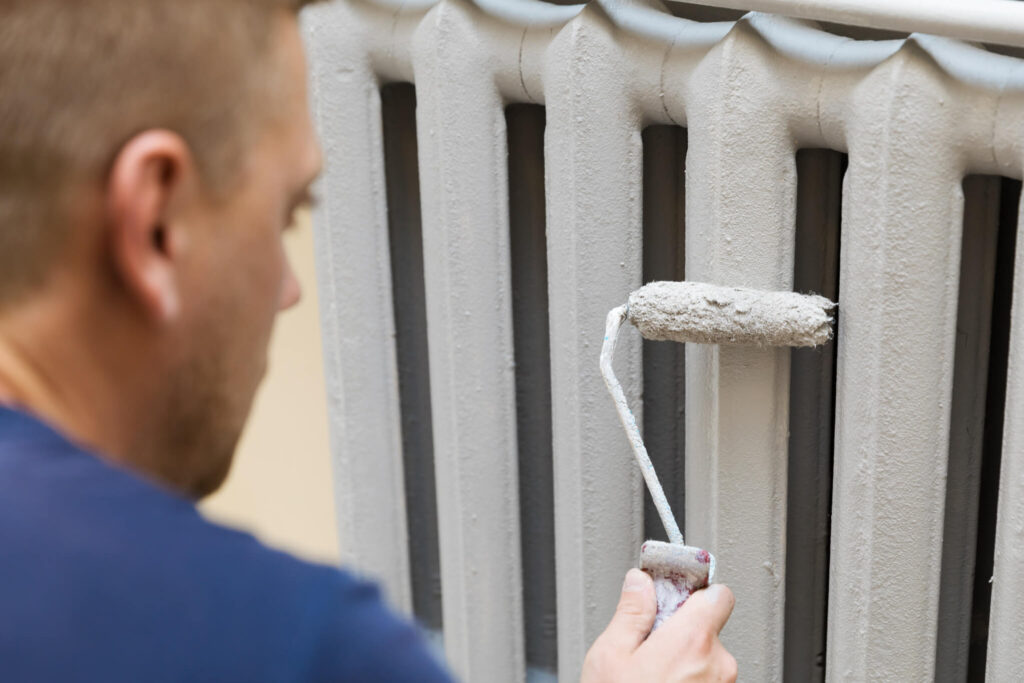
Now you are ready to paint your radiator, but just before you grab your tin of paint or spray can, you need to mask off everything you don’t want paint on. Pop some old newspaper on the floor around the radiator, or use a dust sheet.
You can also mask off the walls too. If you’re using tinned paint and a brush, masking off the walls isn’t strictly necessary.
If you’re using spray paint, you will have some overspray, so masking off the walls is essential. To make this easier, you can buy masking tape and paper that covers a larger area quickly.
You will also need to move all of your furniture out of the firing line or cover it completely with a dust sheet if moving it isn’t an option. Any pets must be kept out of the room. This is for the safety of your radiator paint job but also to protect your pets from the fumes.
Lastly, open all the windows in the room (create a thorough draft if possible) to avoid inhaling the paint fumes.
If you’re painting a new radiator or one that you have sanded back to bare metal, you’ll need to prime the surface before you paint it.
Any good quality metal primer will work nicely for this. If you intend to use spray paint for your final finish, use a spray primer too. That way, there will be no brush strokes in your final finish. If you have simply scruffed up the paint, there is no need to use a primer.
Remember, priming is a very important step in painting. If the primer doesn’t go on nicely, the paint on top of it won’t either.
So, take your time with priming to ensure an even coat. Once the primer has dried, you’re ready to paint your radiator.
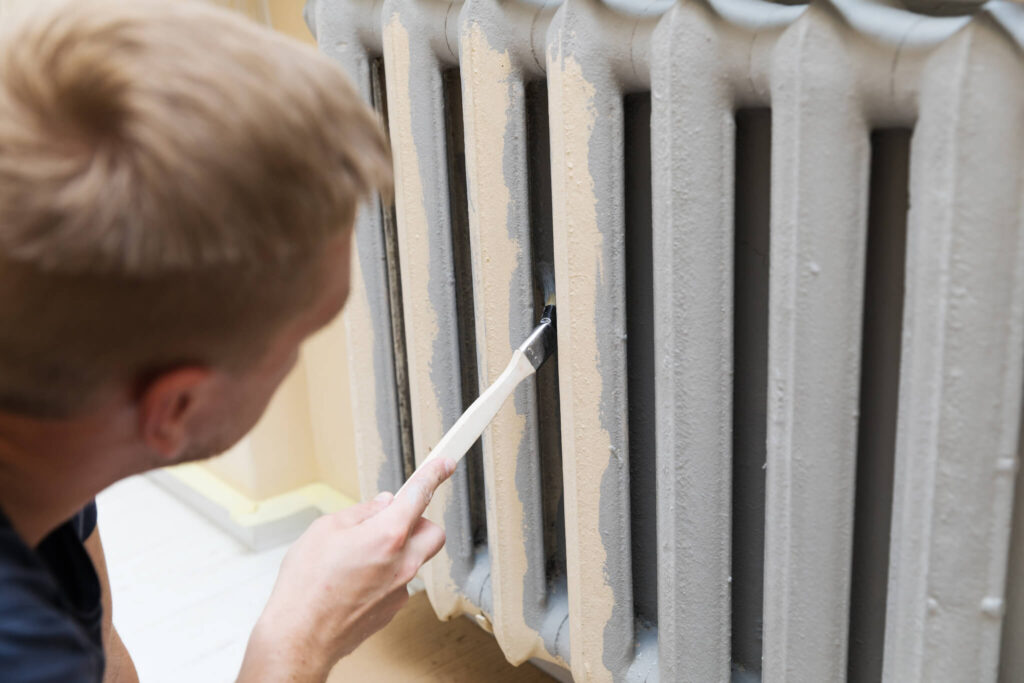
Give your paint a really good stir. You want to stir your paint for at least a few minutes. Listen to a song, or sing a song as you mix. This is really important to make sure the bonding agents and the pigments in the paint are mixed correctly. If you’re using spray paint, give it a good shake for a few minutes. Pretend you’re serving James Bond his famous Martini. You wouldn’t serve James Bond an unshaken Martini, would you?
Whether you’re painting with a brush or spraying, it is much easier to start with all of the fiddly bits and the outer edges of your radiator. The fiddly bits are the top and the sides of the radiator.
Next up, start painting the ridges of the radiator. Work vertically and ensure even coverage moving from one side to the other. Overlap your brush strokes or your spray. This will make sure you are left with a nice finish.
If you are using spray paint, you’ll want to make the flow of paint as even as possible. To do this, you need to move fluidly and constantly. If you’ve never used spray paint before, buy some cheap stuff and practise on cardboard before doing your radiator. It will make all the difference.
Sometimes a second coat is required, but this really depends on how well the first coat went on. If you notice any thin patches, a second coat would be advised. However, if the first coat went on nicely, you can consider that radiator finished and move on to the next.
When you’re decorating your home, painting walls and rearranging furniture can really make a room feel and look brand new and exciting. However, painting radiators is a great way to breathe new life into a room. In fact, it is a vital step in renovating any room. Newly painted walls can really make a radiator look down in dumps and old. If you’re about to paint a few rooms in your home and want to paint the radiators in that room too, you’re in the right place.
Today, we’re exploring the best radiator paint available in the UK now. We’ll also be talking through how to paint a radiator with a paintbrush or a spray can. And tackling some FAQs about painting radiators as well. First, though, let’s find out what makes radiator paint special and why you shouldn’t use anything else to paint your radiators, shall we?
Next up, start painting the ridges of the radiator. Work vertically and ensure even coverage moving from one side to the other. Overlap your brush strokes or your spray. This will make sure you are left with a nice finish.
If you are using spray paint, you’ll want to make the flow of paint as even as possible. To do this, you need to move fluidly and constantly. If you’ve never used spray paint before, buy some cheap stuff and practise on cardboard before doing your radiator. It will make all the difference.
Sometimes a second coat is required, but this really depends on how well the first coat went on. If you notice any thin patches, a second coat would be advised. However, if the first coat went on nicely, you can consider that radiator finished and move on to the next.
Painting a radiator is a great idea. It will breathe new life into a freshly decorated room way more than simply cleaning the radiator will. Nowadays, there are loads of options for finishes and colours of radiator paints too. So, you can really improve the look of a room just by choosing the best radiator paint for the look you are after.
Spray painting a radiator is a great option if the radiator already has a really good finish. The factory finish on a radiator, for example, is a spray enamel finish. Using spray paint over a smooth, flat surface ensures the best finish possible.
However, if your radiator has already been painted and has visible brush strokes from the last time it was painted, spraying the new paint won’t cover these brush strokes. Unless you love hand sanding and many hours of it, using a paintbrush is absolutely fine in this case.
Painting a radiator with a brush will always introduce brushstrokes that will be visible in certain light. It is nearly impossible to paint with a brush and make brush strokes disappear. So, for the most professional paint job possible, we would recommend using spray paint.
No, you must use radiator paint or heat resistant paint. Normal household paint and even most paint designed for metal cannot withstand the heat that radiators produce and will crack and peel over time. For the best and longest-lasting finish possible, a good quality radiator paint must be used.
We hope this look at radiator paint has helped you find the best radiator paint for your needs, and you’ve learnt how to paint a radiator correctly. For more painting and tips and tricks, as well as the best paints and decorating equipment on the market right now, explore Chameleon further. We have everything you need to renovate the look of your home right here.